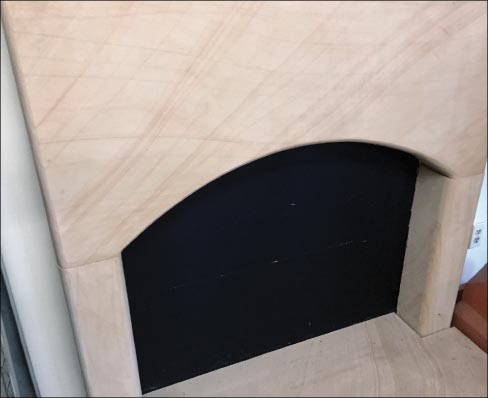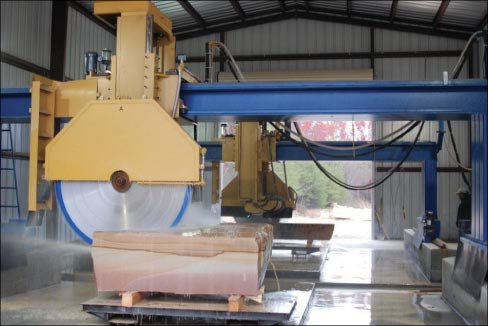Restoration and Maintenance Corner: Quartzite, Crab Orchard and Bluestone
Bob Murrell
Stone Restoration
Photos provided by Bob Murrell (Mouse over photos for captions)
 Most types of quartz-based stones are clastic sedimentary stone, composed of particles or grains usually cemented with varying amounts of either hydrous silica or crystalline quartz.
Most types of quartz-based stones are clastic sedimentary stone, composed of particles or grains usually cemented with varying amounts of either hydrous silica or crystalline quartz.
In laymen’s terms, most are simply either sandstone or metamorphic (created by heat and pressure) sandstone.
 The groups as defined by the MIA Design Manual are Quartz, Crystalline Quartz, Sandstone, Quartzite, Metaquartzite, Quartz Pebble, Metaconglomerates, Chert, Agate, and Flint.
The groups as defined by the MIA Design Manual are Quartz, Crystalline Quartz, Sandstone, Quartzite, Metaquartzite, Quartz Pebble, Metaconglomerates, Chert, Agate, and Flint.
Quartz is composed of the two most abundant elements in the Earth’s crust: silicon and oxygen, which respectively make up 28% and 47% by weight of our planet’s lithosphere. Of all the common minerals, quartz lasts the longest in the environment. Most of the beaches in the world, with a few exceptions, are quartz sand. Now, that is interesting.
Quartz has a Mohs Scale hardness rating of 7 (talc =1 and diamond =10), much like that of granite. It takes a higher Mohs Scale number to scratch a lower number. Quartzite and sandstone are hard durable materials.
 The colors found in quartzite are primarily due to iron oxides. The presence of limonite usually yields yellow, brown, and buff shades; the presence of hematite yields darker brown or red. Illite, sericite, and chloritic minerals supply blue hues–like Bluestone. Of course this group is composed of natural stones so there may be other elements in the stones which may add color or character– at no extra charge.
The colors found in quartzite are primarily due to iron oxides. The presence of limonite usually yields yellow, brown, and buff shades; the presence of hematite yields darker brown or red. Illite, sericite, and chloritic minerals supply blue hues–like Bluestone. Of course this group is composed of natural stones so there may be other elements in the stones which may add color or character– at no extra charge.
 Many of the quartzites quarried in the Crossville, Tennessee area are capable of taking different surface finishes like natural cleft, sandblasted, thermal, saw cut, honed, and even take a polish. The Crab Orchard variety is very popular. It depends on the type of quartz-based stone and the finish required for the project to determine which surface is best to use. Crab Orchard is excellent for flagging, stacked stone, pool surrounds, walkways, patios, countertops, and many other installations. Of course being from Tennessee, I am partial to this beautiful warm brown stone.
Many of the quartzites quarried in the Crossville, Tennessee area are capable of taking different surface finishes like natural cleft, sandblasted, thermal, saw cut, honed, and even take a polish. The Crab Orchard variety is very popular. It depends on the type of quartz-based stone and the finish required for the project to determine which surface is best to use. Crab Orchard is excellent for flagging, stacked stone, pool surrounds, walkways, patios, countertops, and many other installations. Of course being from Tennessee, I am partial to this beautiful warm brown stone.
American Bluestone, which is a dark gray coarse-grained sandstone from the Northeast, is also in this category. Quarried in PA, NY and all the way up into Canada, it is a very common stone used in many building applications.
 Brownstone is another type of sandstone that is very popular in the Midwest and Northeast.
Brownstone is another type of sandstone that is very popular in the Midwest and Northeast.
Porosity with these materials is varied based on the particular stone and surface finish. In most all situations, use of an impregnator will help render the stone surface more resistant to staining and reduce freeze-thaw concerns.
True impregnators should not appreciably affect the permeability (ability to pass vapor) of the stone or the natural appearance. There are also intensifier impregnators or penetrating sealers that will enhance the natural colors on honed or textured surfaces.
Many customers prefer the intensified look which brings out the beauty, character, and natural colors of these stones. In any case, it is advised to protect these stones with the impregnator of personal choice.
Routine maintenance for stone that is used for countertops, flooring, and other applications should be accomplished with either a quality neutral cleaner or natural stone soap.
For polished finishes, I would recommend a pH neutral cleaner and for all honed and textured materials I would recommend the stone soap. The reason is that a good stone soap actually leaves behind conditioners which are good for most all porous honed or textured materials.
However, use of a stone soap may leave a slight film behind on denser polished surfaces, which could require buffing.
Occasionally, exterior stone may need a combination of a deep cleaner with a good pressure washing. Interior periodic intensive cleaning can be accomplished with the deep cleaner and a nylon scrub brush on textured and honed materials as well as helping to clean the grout.
On an annual basis or after any deep cleaning, always test to see if the stone needs more impregnator. An impregnator integrity test is very complicated–Not! Simply pour a small amount of clean water on the stone to make sure it still beads satisfactorily. If it does not or turns dark quickly, that means water is being absorbed, and it is safe to assume you can apply more impregnator.
These stones have been used in the dimensional stone industry for hundreds of years and are becoming even more popular today. So the chances of running into one are increasing. They are fairly durable and chemically resistant materials and not overly sensitive but like any material, they are subject to environmental contaminants.
Always try to submit a test area to confirm the products, procedure, and results. And of course, partner with a reputable distributor for quality products and technical support. Braxton-Bragg has high-quality pH neutral cleaners, stone soaps, and impregnators that work well with quartzites.
Bob Murrell has worked as a supplier of products and technical support to the natural stone industry for over 35 years. He has written numerous articles for various trade publications and has also trained thousands of contractors over the last 25 years.